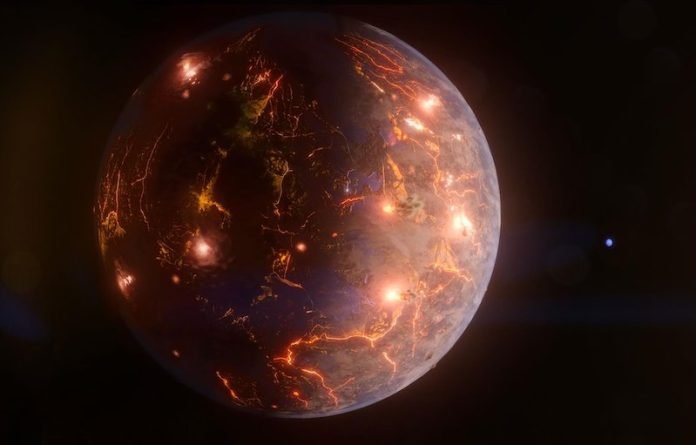
In an intriguing development, astronomers have discovered an Earth-sized planet named LP 791-18d, which is unlike any planet we’ve seen before.
This celestial body is divided into two distinct halves – one half is always under the light of the day, and the other is locked in perpetual darkness.
As if this dichotomy wasn’t enough to spark curiosity, the planet’s surface is also dotted with active volcanoes.
Location and Unique Attributes
The planet orbits a red dwarf star about 90 light years away from us. What sets LP 791-18d apart is its volcanic activity, which has a crucial role in planetary evolution by contributing to the formation of an atmosphere.
As UC Riverside astrophysicist Stephen Kane explains, an atmosphere is vital as it can potentially harbor liquid water on the planet’s surface – a prerequisite for life as we know it.
Gravitational Tugs and Volcanic Activity
There are two other known planets in the same star system – LP 791-18b and LP 791-18c.
The latter, nearly nine times as massive as Earth and about 2.5 times its size, significantly influences LP 791-18d due to its gravitational pull.
This force disrupts LP 791-18d’s orbit, making it more elliptical than circular, and in turn, creates internal friction on the planet, triggering surface volcanic activity.
How Was This Planet Discovered?
NASA’s Transiting Exoplanet Survey Satellite (TESS) and the now-retired Spitzer Space Telescope provided the data for the discovery.
Stephen Kane was part of the team that first observed the planet using TESS. He also co-authored a paper on the newly found planet, published in the renowned scientific journal Nature.
A Planet That Never Rotates
A standout characteristic of LP 791-18d is its lack of rotation. It’s tidally locked, meaning one side is always facing its star.
While this might make the day side too hot for liquid water, Björn Benneke, a co-author of the paper, speculates that the planet’s widespread volcanic activity might generate an atmosphere conducive for water condensation on the cooler night side.
What Does This Mean for Astrobiology?
While the constant volcanic eruptions might make LP 791-18d an inhospitable place, they provide key information for astrobiology, a field studying the origins of life.
Jessie Christiansen, a co-author of the study, says that volcanic or tectonic activity might be essential for life.
The volcanoes can stir up important life-sustaining materials, like carbon, that could otherwise be trapped in the planet’s crust.
The Volcanic Atmosphere: A Comparison to Venus
The recent detection of active volcanoes on Venus proves that planets of Earth’s size can continue enriching their atmospheres irrespective of plate tectonics.
Volcanic eruptions typically release carbon dioxide and water vapor, which are greenhouse gases that can keep a planet warm.
On Venus, the volcanic carbon dioxide remained in the atmosphere, pushing the planet into a runaway greenhouse state.
Now, Venus has temperatures soaring over 850 degrees Fahrenheit, making life improbable. However, as Kane suggests, it might not always have been this hot.
LP 791-18d, with its volcanic activity, can provide valuable insights into how volcanoes shape planetary environments over time, possibly offering clues to the conditions on Venus and Earth.
The study was published in Nature.
Copyright © 2023 Knowridge Science Report. All rights reserved.



